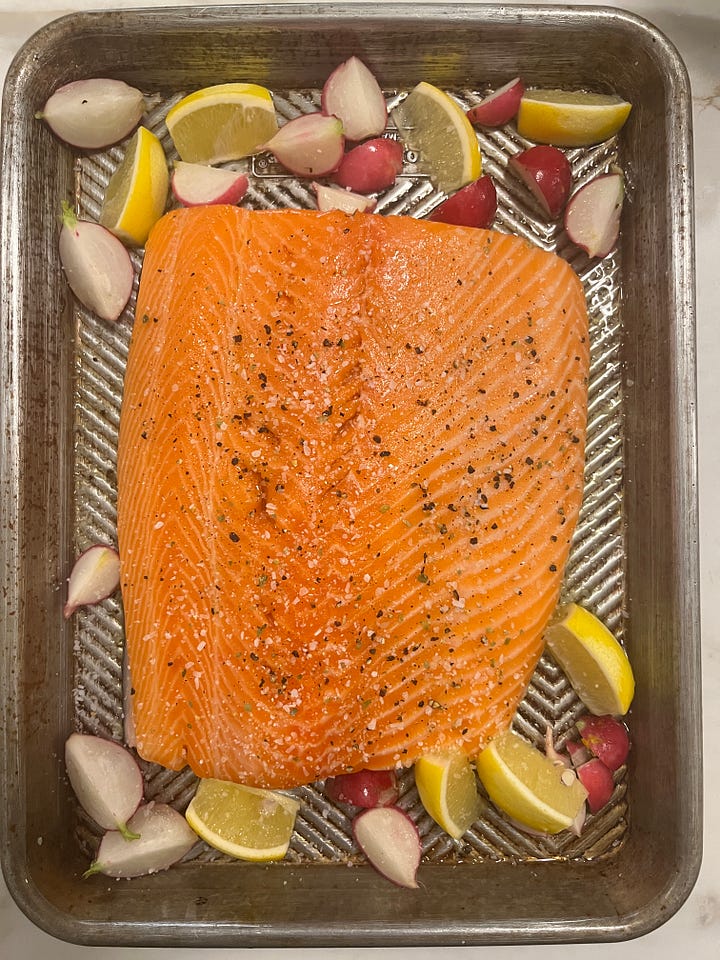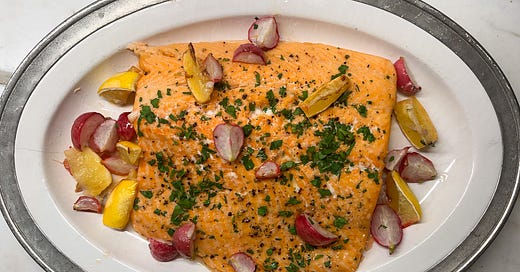Family Style Roast Salmon with Radishes and Meyer Lemons
serve this with boiled baby dutch potatoes (or rice), and steamed or boiled green veg for an easy weeknight dinner
This looks pretty and fancy but is actually SO SIMPLE you really don’t need a recipe (but I’ll give you one, don’t worry!) Like all my roast fish recipes there’s no measuring of anything. You can use salmon or another fish that bakes well: cod, halibut, snapper, or sea bass. The radishes add a fun color pop and I find it fun to use a winter vegetable that doesn’t get much action. What does a roasted radish taste like? They’re a bit of a surprise if you’re used to a sharp, peppery bite when raw. The roasting process transforms them into something much milder, almost sweet, with a subtle nuttiness. The edges can caramelize slightly, giving them a hint of that savory roasted goodness, but they still retain a little of their original radish personality—just mellowed out and more approachable.
I would serve with a simple green veggie (broccolini, snap peas, green beans, asparagus…), salad, roasted (or boiled) baby Dutch potatoes, or rice. Or pair it with lemon risotto above for a citrus-themed feast that’s impressive without trying too hard.
If I’m buying wild salmon my favorite is King/Chinook. I like that it’s buttery, moist and tender with big flakes of meat. If that’s not available and I want salmon, I will buy responsibly farmed Atlantic salmon - it’s close to King salmon in texture and taste. The salmon in the photo above is Ora King Salmon.
In general the differences are:
King salmon - Richer and buttery with a soft and tender texture. Usually thicker fillets.
Sockeye - firm, dense and meaty with a richer fish flavor. Typically wild-caught from Alaska, fresh or frozen.
Coho/Silver - milder than Sockeye, with a subtler flavor.
Atlantic salmon - typically farmed, mild, tender and moist. Usually bigger fillets than coho and sockeye.
I like to buy a big piece of fish (about 1/3 lb per person) rather than individual fillets. This way you only have to worry about cooking ONE piece of fish. Cooking it in the oven means there’s no need for flipping, and no grease splatter on your stove. Buying a bigger piece than you need is a great idea if you want leftovers. When it comes time to roast, you have options! You can cook the salmon on a sheet pan or a deeper baking dish (like a pyrex casserole dish.) It will cook faster on a sheet pan because more of the fish is exposed to hot air flow and the heat will be distributed more evenly. Having an array of big spatulas handy (I have a few) is helpful for transferring salmon like this to a serving dish - or use a regular spatula and serve right from the sheet pan.
Ingredients:
olive oil, salt and peper
1 1/3 pound fillet of salmon
1 bunch of radishes, washed, trimmed and quartered
2 Meyer lemons
optional herbs: a few tablespoons of minced parsley, chives, dill, or basil
Instructions:
Preheat the oven to 375 F
Lay the salmon in an oiled, shallow, oven-proof baking dish; or on an oiled or parchment-covered sheet pan. Drizzle a tablespoon or two of olive oil over the top and use your hands to rub it all over.
Season with salt, pepper and the zest of the Meyer lemons. After you’ve zested the lemons, quarter them and place them around the fish.
Rub the quartered radishes with olive oil and a pinch or salt (I scrunch them up in my hands but you can use a small bowl and toss the radishes in that to coat them if you like doing dishes.) Scatter the radishes around the salmon.


Salmon before and after cooking Bake for 20-30 minutes. The best way to tell if salmon is finished is to take a fork and probe the thickest part. It should flake easily, the flesh should be firm but still moist, and the color should transition from a translucent pink to a more opaque color. If you’re using an instant read thermometer, aim for 125 F.
If you’re boiling or steaming veggies, or making rice, now is the time!
Once salmon is cooked, sprinkle herbs over top and serve with the roasted radishes and lemon over the top. You can transfer it to a serving plater or serve right from the sheet pan.
Like it? Make it? If so, I’d love for you to share, like ❤️, and let me know what you think. Your feedback is important and can spark many ideas. Thanks so much




